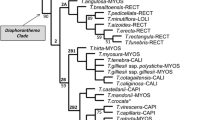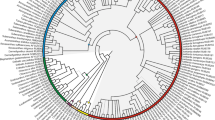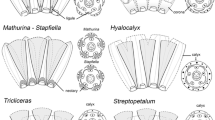Abstract
Graptopetalum is a genus of approximately 17 species of mainly dry habitats from Arizona to Oaxaca. Circumscription of the genus has been problematic. A cladistic analysis was performed based on 39 morphological characters to determine ifGraptopetalum constitutes a monophyletic group and to determine the relationships among the species. Results indicate thatGraptopetalum is not monophyletic. A large clade that includes most of the species ofGraptopetalum is weakly supported. In this clade, two subclades received moderate support, one formed by the acaulescent species and another by the haplostemonous taxa.
Resumen
Graptopetalum es un género de aproximadamente 17 especies principalmente de zonas áridas desde Arizona hasta Oaxaca. La circunscripción del género ha sido problemática. En este artículo se llevó a cabo un análisis cladístico con base en 39 caracteres morfológicos para determinar siGraptopetalum constituye un grupo monofilético y para determinar las relaciones entre sus especies. Los análisis recobraron un clado débilmente soportado que incluye a la mayoría de las especies deGraptopetalum. Dentro de este clado dos subclados recibieron un soporte moderado, uno formado por las especies acaulescentes y otro por las especies haplostémonas.
Similar content being viewed by others
Literature Cited
Acevedo-Rosas, R. & M. J. Cházaro. A new species and a nomenclatural change inGraptopetalum (Crassulaceae). Novon 13: 377–380.
Berger, A. 1930. Crassulaceae.In: A. Engler, & K. Prantl, editors. Die Naturlichen Pflanzenfamilien. Ed. 2. (18a): 352–482. Wilhelm Engelmann, Leipzig.
Brown, N. E. 1914. Decades Kewenses. Kew Bull. 1914: 208–209.
Bullock, A. A. 1937.Sedum paraguayense. Kew Bull. 1937: 276.
Clausen, R. T. 1981. Variation ofSedum of the Mexican Cordilleran Plateau. Published by the author, Ithaca, NY.
Donoghue, M. J. &P. D. Cantino. 1984. The logic and limitations of the outgroup substitution approach to cladistic analysis. Syst. Bot. 9: 192–202.
Felsenstein, J. 1985. Confidence limits on phylogenies: an approach using the bootstrap. Evolution 39: 783–791.
Fitch, W. M. 1971. Toward defining the course of evolution: minimum change for a specific topology. Syst. Zool. 20: 406–416.
Hunt, D. R. 1979.Graptopetalum bellum. Bot. Mag. 182: 130.
Kimnach, M. &R. Moran. 1986.Graptopetalum paraguayense: a history and a new subspecies. Cact. Succ. J. (Los Angeles) 58: 48–56.
Maddison, W. P. &D. R. Maddison. 1992. Mac-Clade: analysis of phylogeny and evolution. Ver. 3.05. Sinauer Associates, Sunderland, Massachusetts.
Moran, R. 1969.Thompsonella minutiflora (Rose) Britton & Rose. Cact. Succ. J. (Los Angeles) 41: 173–177.
— 1984.Graptopetalum rusbyi (Greene) Rose andG. occidentale Rose (Crassulaceae). Cact. Succ. J. (Los Angeles) 56: 169–176.
— &J. Meyrán. 1974.Tacitus bellus. Cact. Succ. Mex. 19: 75.
— &C. H. Uhl. 1968.Graptopetalum fruticosum a new species from Jalisco, Mexico. Cact. Succ. J. (Los Angeles) 40: 152–156.
Mort, M. E., D. E. Soltis, P. S. Soltis, J. Francisco-Ortega &A. Santos-Guerra. 2001. Phylogenetic relationships and evolution of Crassulaceae inferred frommatK sequence data. Amer. J. Bot. 88(1): 76–91.
————&—. 2002. Phylogenetics and evolution of the Macaronesian clade of Crassulaceae inferred from nuclear and chloroplast sequence data. Syst. Bot. 27: 271–288.
Rose, J. N. 1911. Studies of Mexican and Central American Plants. no. 7. Contrib. U.S. Nat. Herbarium 13: 291–312.
— 1922.Byrnesia weinbergii. Addisonia 7: 37–38, pl. 243.
Semarnat. 2002. Norma Oficial Mexicana PROY-NOM-059-ECOL-2001, Protección ambiental—Especies nativas de México de flora y fauna silvestres—Categorías de riesgo y especificationes para su inclusión, exclusión o cambio—Lista de especies en riesgo. Diario Oficial. 6 marzo 2002. México, D.F., Mexico.
Swofford, D. L. 2001. PAUP*. Phylogenetic analysis using parsimony. Ver. 4. Sinauer Associates, Sunderland, Massachusetts.
Uhl, C. H. 1970. Chromosomes ofGraptopetalum andThompsonella (Crassulaceae). Amer. J. Bot. 57: 1115–1121.
Van Ham, R. C. H. J. &H. 't Hart. 1998. Phylogenetic relationships in the Crassulaceae inferred from chloroplast DNA restriction-site variation. Amer. J. Bot. 85: 123–134.
Walther, E. 1931. Alwin Berger's Crassulaceae. Cact. Succ. J. 2: 383–408.
— 1936. Phylogeny ofEcheveria. Cact. Succ. J. 8: 82–88.
— 1938. Notes on Crassulaceae. Cact. Suc. J. 9: 108.
Author information
Authors and Affiliations
Rights and permissions
About this article
Cite this article
Acevedo-Rosas, R., Sosa, V. & Lorea, F.G. Phylogenetic relationships and morphological patterns in Graptopetalum (Crassulaceae). Brittonia 56, 185–194 (2004). https://doi.org/10.1663/0007-196X(2004)056[0185:PRAMPI]2.0.CO;2
Issue Date:
DOI: https://doi.org/10.1663/0007-196X(2004)056[0185:PRAMPI]2.0.CO;2




